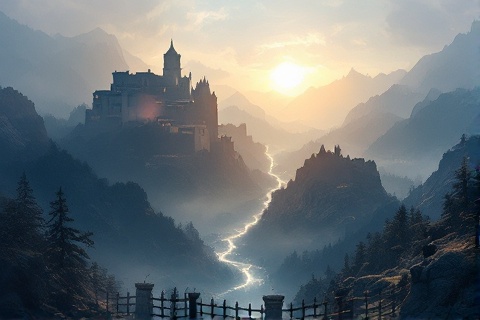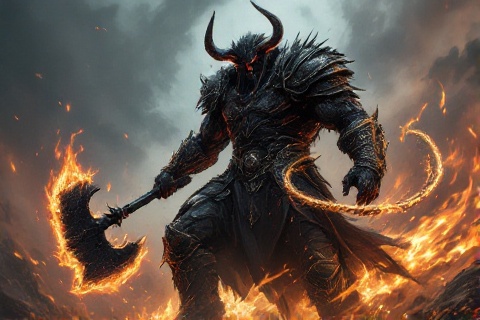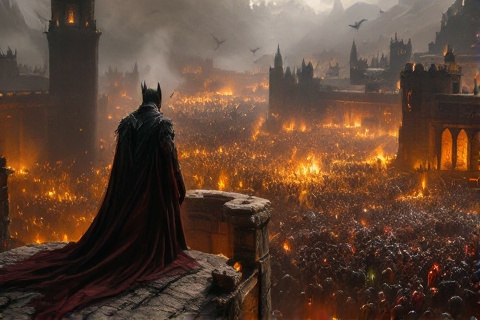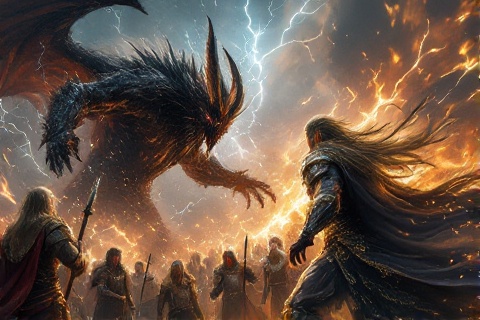
Gothmog: Lord of the Balrogs
Commander of Morgoth's Darkest Forces
Origin and Nature of the Lord of Balrogs

Before becoming the Lord of Balrogs, Gothmog began his existence as one of the
Maiar, the powerful spiritual beings who helped shape the world
alongside the Valar. Like many others, he was seduced by
Melkor's promises and followed the Dark Lord into
rebellion against the other Valar. In Melkor's service, Gothmog rose to become
one of the most formidable servants of evil, second in might only to
Sauron among all of Morgoth's followers. His power was so
great that he took the form of a massive fire-demon, leading the terrible
Balrogs who served as Morgoth's most elite warriors. From his position within
the dark fortress of Angband, Gothmog served as High Captain,
commanding all of Morgoth's armies with ruthless efficiency.
As one of the mightiest of the fallen Maiar, Gothmog's power was almost
unmatched in Middle-earth. His strength and authority in Morgoth's hierarchy
placed him as the supreme commander of the Dark Lord's forces, with only Sauron
wielding greater influence. The corruption that transformed him into a Balrog
enhanced his already considerable powers, making him a being of terrifying
might. As the Lord of Balrogs, he stood as the greatest among these fire-demons,
creatures who were themselves fallen Maiar of immense power. Within the iron
fortress of Angband, he served as Morgoth's most trusted military commander,
directing the Dark Lord's armies and planning their campaigns against the free
peoples of Beleriand.
When Gothmog chose to follow Morgoth, he took the form that would become
legendary throughout the First Age. As a Balrog, he manifested
as a creature of shadow and flame, towering over his foes with wings of shadow
and wielding weapons of fire. This transformation reflected the corruption of
his original noble nature as a Maia into something terrible and dark. The
position of Lord of Balrogs gave him authority over all other fire-demons in
Morgoth's service, making him the supreme commander of these dreaded beings.
From his seat of power in Angband, Gothmog established himself as the High
Captain of all Morgoth's forces, proving himself a commander of exceptional
skill and brutality.
Within the dark fortress of Angband, Gothmog established his role as High
Captain with terrible efficiency. He organized Morgoth's armies into a
formidable fighting force, coordinating between the various creatures and beings
that served the Dark Lord. His position in Angband made him responsible for the
fortress's military operations and the deployment of Morgoth's forces across
Beleriand. The iron walls and deep dungeons of Angband served as his command
center, from which he directed countless assaults against the
Elves and their allies throughout the First Age.
Physical Description and Powers

Among all the Balrogs, Gothmog stood apart in his physical presence and power.
His massive form dwarfed even his fellow Balrogs, who were themselves creatures
of terrifying size and strength. The shadow and flame that made up his being
reached heights that struck fear into the hearts of even the bravest warriors
who faced him in battle. His immense size reflected his status as the greatest
of all Balrogs, making him an imposing figure on any battlefield he entered.
Gothmog's arsenal included weapons that perfectly complemented his tremendous
strength and skill in battle. His primary weapons were a massive black axe and a
whip of flame, both of which he wielded with devastating effect against his
enemies. The black axe could cleave through armor and flesh with terrible force,
while his whip of flame could strike fear into his foes before they even engaged
in direct combat. These weapons became infamous throughout Beleriand, and the
sight of them on the battlefield often signaled doom for Morgoth's enemies.
As a being of shadow and flame, Gothmog commanded these elements as natural
extensions of his will. The darkness that surrounded him could obscure the
vision of his enemies and instill terror in their hearts, while the flames he
controlled could reduce warriors and weapons to ash. These elemental powers were
not merely tools but fundamental aspects of his being, making him a walking
embodiment of destruction. His mastery over these forces made him particularly
effective in battle, as he could combine physical combat with devastating
elemental attacks.
Role in Morgoth's Army
As High Captain of Angband, Gothmog's military authority was absolute, second
only to Morgoth himself. He commanded not just the Balrogs but all of Morgoth's
vast armies, from the countless Orcs to the mighty
Dragons. His position required him to coordinate massive
military campaigns across Beleriand, managing the movements and actions of
diverse forces with remarkable skill. Under his leadership, Morgoth's armies
achieved their greatest victories against the Noldor and their
allies.
Throughout the First Age, Gothmog led the Balrogs in many of the most
significant battles against the Elves and their allies. His presence on the
battlefield often proved decisive, as the Balrogs under his command could break
through even the strongest enemy lines. The coordination between these powerful
beings was a testament to Gothmog's leadership abilities, as he directed their
attacks to maximum effect. His understanding of how to best utilize the Balrogs'
unique abilities made them an even more formidable force under his command.
Gothmog's skill as a commander extended beyond leading the Balrogs, as he
expertly coordinated between all branches of Morgoth's forces. He understood how
to combine the raw strength of Dragons with the overwhelming numbers of Orcs and
the terror of the Balrogs to achieve victory. His ability to manage these
diverse forces and use their different strengths in concert made Morgoth's
armies particularly effective. The cooperation between these various creatures
and beings was a crucial factor in many of their victories.
As a military strategist, Gothmog demonstrated remarkable tactical insight and
battlefield awareness. He could quickly assess battle situations and adjust his
strategies accordingly, often turning seemingly even battles into decisive
victories for Morgoth's forces. His command decisions were characterized by both
boldness and careful calculation, making him an unpredictable and dangerous
opponent. The success of many of Morgoth's major campaigns can be attributed to
Gothmog's tactical expertise and strategic planning.
The Siege of Angband

During the long Siege of Angband, Gothmog proved his worth as a defensive
commander. He maintained the fortress's defenses against the mighty hosts of the
Noldor, ensuring that Morgoth's stronghold remained impregnable. His leadership
during this period kept the dark lord's forces organized and ready despite being
contained within their fortress. The maintenance of Angband's defenses under his
command prevented the Noldor from achieving any significant breakthroughs during
the siege.
Even while contained by the siege, Gothmog worked tirelessly to maintain the
fighting capability of Morgoth's armies. He used the time to train and organize
the forces under his command, ensuring they remained battle-ready despite their
confinement. His efforts during this period included regular drills and
exercises that kept the troops prepared for eventual combat. The professional
military organization he maintained during the siege would prove crucial in
later battles.
Under Gothmog's leadership, the forces within Angband prepared extensively for
the eventual breaking of the siege. He developed the strategies and trained the
troops that would later prove decisive in the Dagor Bragollach, the Battle of
Sudden Flame. His preparation included positioning forces for maximum effect and
ensuring all troops understood their roles in the coming battle. These careful
preparations would ultimately contribute to the devastating success of Morgoth's
forces when they finally broke free.
The Battle of Unnumbered Tears
Gothmog's mastery of battlefield tactics was perhaps best demonstrated in his
use of flanking maneuvers during major engagements. His ability to identify and
exploit weaknesses in enemy formations allowed him to turn the tide of battle in
crucial moments. The timing and execution of these maneuvers showed his deep
understanding of battlefield dynamics and troop movements. His flanking attacks
were particularly effective because they often struck at the least expected
moment and location.
During the fateful battle of the Nirnaeth Arnoediad, Gothmog's command of the
reserve forces proved decisive. He held these troops back until the perfect
moment, then deployed them to shatter the Union of Maedhros at its weakest
point. His patience and tactical acumen in this battle demonstrated why he was
considered such a formidable commander. The destruction of the greatest alliance
ever formed against Morgoth was largely due to his strategic brilliance.
When faced with the combined might of Elves and Men, Gothmog's tactical
superiority became even more apparent. He understood how to exploit the
differences between these allied forces and use their strengths against them.
His strategies often involved separating these allies on the battlefield,
preventing them from supporting each other effectively. The success of his
tactics against such powerful alliances further cemented his reputation as a
brilliant military commander.
Notable Victories in Combat

One of Gothmog's most notable victories was his defeat of
Fëanor, the High King of the Noldor and creator of the
Silmarils. When Fëanor pushed too far ahead of his forces
in his assault on Angband, Gothmog seized the opportunity to confront him. The
battle between these mighty beings ended with Fëanor receiving mortal wounds
from Gothmog and his Balrogs. This victory early in the Wars of Beleriand
demonstrated Gothmog's tremendous combat prowess and struck a significant blow
against the Noldor.
Another of Gothmog's legendary victories came in his battle against Fingon, who
had become High King of the Noldor. During the Nirnaeth Arnoediad, Gothmog
managed to separate Fingon from the main host of his army. The Lord of Balrogs
then engaged Fingon in combat, ultimately defeating and slaying him with the
help of another Balrog. This victory removed one of the most valiant leaders of
the Elves from the field of battle.
The capture of Húrin during the Nirnaeth Arnoediad further demonstrated
Gothmog's combat abilities and tactical mind. Despite Húrin's incredible last
stand, where he slew many of Morgoth's troops, Gothmog successfully coordinated
the effort to capture him alive. This achievement was particularly notable given
Húrin's renowned fighting skill and determination. The capture of such a mighty
warrior added another significant victory to Gothmog's list of accomplishments.
Throughout his long service to Morgoth, Gothmog remained undefeated in personal
combat until his final battle. His combination of physical might, combat skill,
and tactical awareness made him nearly invincible on the battlefield. He
consistently prevailed against the greatest warriors of the First Age, earning a
fearsome reputation among all who opposed Morgoth. His string of victories
against such powerful opponents made him one of the most dreaded beings in all
of Beleriand.
The Fall of Gondolin

The assault on Gondolin represented Gothmog's final major
military campaign. He led a massive force of Balrogs, Dragons, and other
creatures in the attack on this hidden city of the Noldor. His leadership was
crucial in breaching the city's defenses and coordinating the various elements
of Morgoth's army. The fall of Gondolin would prove to be both his greatest
victory and his final battle.
In the streets of Gondolin, Gothmog faced his greatest challenger in Ecthelion
of the Fountain, one of the city's mightiest defenders. Their confrontation was
one of the most legendary duels of the First Age, as these two powerful warriors
engaged in mortal combat. The battle between them represented a clash between
the highest martial skills of both the forces of good and evil.
The duel between Gothmog and Ecthelion ended in mutual destruction, as both
warriors perished in their final encounter. Ecthelion drove his spiked helmet
into Gothmog's chest while both fell into the Fountain of the King. The cold
waters of the fountain proved fatal to Gothmog, extinguishing his flames
forever. This dramatic end marked the conclusion of Gothmog's long reign of
terror.
The death of Gothmog represented a severe loss for Morgoth's forces, as they
lost their most capable military commander. His absence would be keenly felt in
the remaining battles of the First Age, as no other commander could match his
combination of personal might and tactical brilliance. The loss of such a
powerful leader marked a significant turning point in the war against Morgoth.
Legacy and Impact
In all the recorded histories of Middle-earth, Gothmog stands as the most
powerful and fearsome of all Balrogs. His combination of physical might,
tactical brilliance, and leadership ability set him apart from all others of his
kind. The terror he inspired in his enemies and the respect he commanded from
his allies marked him as a truly exceptional being, even among the mighty
servants of Morgoth.
The military successes achieved under Gothmog's leadership were crucial to
Morgoth's dominion over Beleriand during the First Age. His tactical expertise
and battlefield prowess contributed to many of the Dark Lord's greatest
victories against the Noldor and their allies. The strategies he developed and
the military organization he created would influence the conduct of warfare
throughout the First Age.
When Gothmog fell in Gondolin, it marked a significant shift in the balance of
power during the War of Wrath. The loss of such a
capable commander weakened Morgoth's forces at a crucial time, contributing to
their eventual defeat. His death represented not just the loss of a powerful
warrior, but the end of an era in the wars of Beleriand. The void left by his
fall would never truly be filled in Morgoth's armies.
